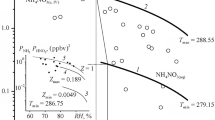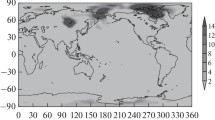Abstract
The effects of small air ions were observed on the course of influenza in specific pathogen-free mice challenged by intranasal instillation of measured doses of influenza virus and maintained in a controlled micro-environment. Unipolar low densities of positive or negative ions increased the death rate, while mid-range densities of either charge were without effect. High concentrations of negative ions or low concentrations of mixed ions with negative ions predominating reduced the death rate. Ion depleted air, a common product of urban living conditions, significantly increased the mortality rate.
Zusammenfassung
Die Wirkung kleiner Luftionen auf den Verlauf der Influenza wurde in SPF Mäusen nach intranasaler Application von bekannten Mengen Influenzavirus unter kontrollierten Umweltbedingungen untersucht. Unipolare niedrige Konzentrationen positiver und negativer Ionen erhöhten die Mortalität, während mittlere Konzentration Ionen beider Ladungen ohne Wirkung blieben. Hohe Konzentrationen negativer Ionen oder niedrige Konzentrationen gemischter Ionen mit überwiegend negativen Ionen senkten die Mortalität. Luft ohne Ionen, wie unter städtischen Lebensbedingungen, steigerten die Mortalität signifikant.
Resume
On a suivi l'effet de petits ions de l'air sur le développement de la grippe chez des souris libres d'agents pathogènes, infectées par instillation intransale au moyen de doses connues de virus et ensuite maintenues en atmosphère contrôllée. De faibles concentrations unipolaires d'ions positifs ou négatifs augmentent le taux de mortalité, alors que des concentrations moyennes de chacune des charges sont sans effet. Par contre, de fortes concentrations d'ions négatifs diminuent le taux de mortalité. Une atmosphère privée d'ions, telle qu'on en rencontre dans les villes, augmente le taux de mortalité de façon significative.
Similar content being viewed by others
References
D'ALIBARD, T.F. (1752): Letter to Acad. de Sci. (3).
ANDERSEN, I. and VAD, E. (1965). The influence of electric fields on bacterial growth. Int. J. Biometeor., 9: 211–218.
ANDERSEN, I. (1969): The effect of ionized air on ciliary activity in trachea. Biometeorology 4. S.W. Tromp and W.H. Weihe (ed.), Suppl. Int.J.Biometeor., Swets & Zeitlinger, Amsterdam, Part II, 135.
BACHMAN, C.H., McDONALD, R.A. and LORENZ, C.J. (1966): Some effects of air ions on the activity of rats. Int. J. Biometeor., 10: 39–46.
BECKETT, J.C. (1959): Dynamics of Fresh Air. J.Amer. Soc. Heating, Refrigerating and Air Conditioning, 1: 47–51.
BERTHOLON, L'ABBÉ P. (1780): De l'Electricité du Corps Humain dans l'État de Santé et de Maladie. Lyons, Bernuset.
CHALMERS, J.A. (1957): Atmospheric Electricity. Pergamon Press, London.
CUPCEA, S., DELEANU, M. and FRITS, T. (1959): L'action de l'air ionisé sur le trophisme de la muqueuse gastrique dans l'ulcère expérimental. Comunicarile Acad. RPR, 9: 289–295.
CZERMAK, P. (1901): Uber Elektrizitätszerstreuung bei Foehn. Mitt. d. Wien. Akad. f. Weiss., 27.
DANON, A., WELLER, C.P. and SULMAN, F.G. (1969): Effect of dry, hot desert winds on man. Biometeorology 4. S.W. Tromp and W.H. Weihe (ed.). Suppl. Int. J. Biometeor., Swets & Zeitlinger, Amsterdam, Part II, 71–72.
DAVID, T.A., MINEHART, J.R. and KORNBLUEH, I.H. (1960): Polarized air as an adjunct in the treatment of burns. Amer. J. Phys. Med., 39: 111–113.
DELEANU, M., FRITS, T. and FLOREA, E. (1965): L'action de l'air ionisé dans le traitement des ulcères gastroduodénaux. Int. J. Biometeor., 9: 161–165.
EICHMEIER, J.A. (1969): Das Verhalten der natürlichen Klein- und Grossionenkonzentration in geschlossenen Räumen. Int. J. Biometeor., 13: 51–60.
ELSTER, J. and GEITEL, H. (1899): Über die Existenz Elektrischer Ionen in der Atmosphere. Terrestr. Magazin, 4.
FRANKLIN, B. (1750): Letter to Royal Society.
FRANKLIN, B. (1752): (No title). Phil. Trans., 47: 289.
FREY, A.H. (1967): Modification of the conditioned emotional response by treatment with small negative air ions. Publication from the Institute for Research, State College, Pennsylvania.
GARATTINI, S. and VALZELLI, L. (1965): Serotonin. Elsevier Publishing Co., Amsterdam.
GILBERT, G.O. (1971): Effect of negative air ions upon emotionality and brain serotonin levels in isolated rats. Thesis, Pacific Lutheran University.
GRAY, S. (1735): (No title). Phil. Trans., 39: 400.
GUILLERM, R., BADRE, R. and HEE, J. (1966): Effects of light atmospheric ions on the ciliary activity of sheep and rabbit tracheal mucosa in vitro. C.R.Acad. Sci. (D) (Paris), 262: 669–71.
HICKS, W.W. (1957): A series of experiments on trees and plants in electrostatic fields. J. Franklin Inst., 264: 1–5.
KALLOS, P. and KALLOS-DEFFNER, L. (1957): Effect of inoculations with H. Pertussis vaccine on susceptibility of albino mice to 5-hydroxytryptamine (serotonin). Int. Arch.Allergy, 11: 237–245.
KIMURA, S., ASHIBA, M. and MATSUSHIMA, L. (1939): Influence of air lacking in light ions and the effect of its artificial ionization upon human beings in occupied rooms. Jap. J. Med. Sci., 7: 1–12.
KNOLL, M., EICHMEIER, J. and SCHON, R.W. (1964): Properties, measurement and bioclimatic action of "Small" multimolecular atmospheric ions. Advances in Electronics and Electronphysics, 19: 177–254.
KONG, Y.M., LEVINE, H.B., MADIN, S.H. and SMITH, C.E. (1964): Fungal multiplication and histopathological changes in vaccinated mice infected with COCCIDIOIDES IMMITIS. J. Immunol., 92: 779–790.
KÖNIG, H.L. (1960): Ultra-low frequency atmospherics. 1960 IRE International Convention Record. New York, New York. Part I, 128–133.
KÖNIG, H.L. (1962): Über den Einfluss besonders niederfrequenter elektrischer Vorgänge in der Atmosphäre auf die Umwelt. Z. angew. Bäder- und Klimaheilk., 9: 481–501.
KORNBLUEH, I.H. (1962): Artificial ionization of the air and its biological significance. Clin. Med., 68: 1779–1787.
KORNBLUEH, I.H. (1967): Air ions and human health. Seminar on human biometeorology. US Department of Health, Education and Welfare, Public Health Service, Cincinnatti, 145–159.
KORNBLUEH, I.H. (1971): Aeroionization in physical medicine. Z. Physiother., 2: 81–85.
KRUEGER, A.P., ANDRIESE, P.C. and KOTAKA, S. (1963): The biological mechanism of air ion action: The effect of CO2 + in inhaled air on the blood level of 5-hydroxytryptamine in mice. Int. J. Biometeor., 7: 3–16.
KRUEGER, A.P., ANDRIESE, P.C. and KOTAKA, S. (1968): Small air ions: Their effect on blood levels of serotonin in terms of modern physical theory. Int. J. Biometeor., 12: 225–239.
KRUEGER, A.P., KOTAKA, S. and ANDRIESE, P.C. (1966): Studies on the biological effects of gaseous ions: A review. Special Monograph Series, Vol. 1. Biometeorological Research Centre, Leiden.
KRUEGER, A.P., KOTAKA, S., REED, E.J. and TURNER, S. (1970): The effect of air ions on bacterial and viral pneumonia in mice. Int. J. Biometeor., 14: 247–260.
KRUEGER, A.P., KOTAKA, S. and REED, E.J. (1971): The course of experimental influenza in mice maintained in high concentrations of small negative air ions. Int. J. Biometeor., 15: 5–10.
KRUEGER, A.P. and LEVINE, H.B. (1967): The effect of unipolar positively ionized air on the course of coccidioidomycosis in mice. Int. J. Biometeor., 10: 279–288.
KRUEGER, A.P. and SMITH, R.F. (1958): The effects of air ions on the living mammalian trachea. J. Gen. Physiol., 42: 69–82.
KRUEGER, A.P. and SMITH, R.F. (1960a): The biological mechanisms of air ion action. I. 5-hydroxytryptamine as the endogenous mediator of positive air ion effects on the mammalian trachea. J. Gen. Physiol., 43: 533–540.
KRUEGER, A.P. and SMITH, R.F. (1960b): The biological mechanisms of air ion action. II. Negative air ion effects on the concentration and metabolism of 5-hydroxytryptamine in the mammalian respiratory tract. J. Gen. Physiol., 44: 269–276.
LEMMONIER, L.G. (1752): Observations sur l'électricité de l'air. Mém. Acad. Sci., 2: 233–236.
LEVINE, H.B. and KONG, Y.M. (1966): Immunological impairment in mice treated intravenously with killed COCCIDIOIDES IMMITIS spherules: suppressed response to intramuscular doses. J.Immunol., 97: 297–3.
LEVINE, H.B. and MADIN, S.H. (1962): Enhancement of experimental coccidioidomycosis with testostorone and oestradiol. Sabouraudia (Great Britain), 2; 47–55.
MAÇZÝNSKI, B., TYCZKA, S., MARECKI, B. and GORA, T. (1971): Effect of the presence of man on the air ion density in an office room. Int. J. Biometeor., 15: 11–21.
NAUMOV, G.P. (1965): Use of antibiotic electroaerosols in selected chronic diseases of the upper respiratory tract. Dissertation, Moscow, 1965.
NAZZARO, J.R., JACKSON, D.E. and PERKINS, L.E. (1967): Effects of ionized air on stress behavior. Med. Res. Engin., 6: 25–28.
PAGE, I.H. (1968): Serotonin. Yearbook Medical Publishers, Chicago, p.47.
PALTI, Y., DeNOUR, E. and ABRAMOV, A. (1966): The effect of atmospheric ions on the respiratory system of infants. Pediatrics, 38: 405–411.
PAPPAGIANIS, D. (1955): Factors associated with virulence of COCCICIOIDES IMMITIS. Ph.D. Thesis, University of California, Berkeley.
REITER, R. (1960): Meteorobiologie und Elektrizität der Atmosphäre. Akad. Verlagsgesellschaft. Geest & Portig, Leipzig.
ROBINSON, N. and DIRNFIELD, F.S. (1963): The ionization state of the atmosphere as a function of the meteorological elements and of various sources of ions. Int. J. Biometeor., 4: 101–110.
SIDAWAY, G.H. (1966): Influence of electrostatic fields on seed germination. Nature (Lond.), 211: 303.
SILVERMAN, D. and KORNBLUEH, I.H. (1957): The effect of artificial ionization of the air on the electro-encephalogram. Amer. J. phys. Med., 36: 352–358.
SKOROBOGATOVA, A.M. (1969): Some effects of the ionized air and electroaerosols on man. Problemy Elektroaerozol, Tartu, 87–89 (in Russian).
TROMP, S.W. (1968): A survey of recent advances in electro-biometeorology. Reports of the Biometeorological Research Centre, Leiden, No. 10, June 1968: 1–15.
WALL, W. (1708): (No title). Phil. Trans., 26: 79.
WEHNER, A.P. (1964): Growth of microorganisms in electrostatic fields. Int. J. Biometeor., 7: 277–282.
WEHNER, A.P. (1971): Negatively charged aerosols. Effect on pulmonary clearance of inhaled239PuO2 in rats. Chest, 60: 468–471.
WILSON, C.T.R. (1900): On the leakage of electricity through dust-free air. Proc. Camb.Phil.Soc., 11: 32–34.
WINKLER, J.H. (1746): Die Stärke der elektrischen Kraft des Wassers. Breitkopf, Leipzig.
WINSOR, T. and BECKETT, J.C. (1958): Biological effects of ionized air in man. Amer. J. phys. Med., 37: 83–89.
WON, W.D. and ROSS, H. (1971): Relationship of low temperature to mouse resistance to infection with Klebsiella pneumoniae. Aerospace Med., 42: 642–645.
Author information
Authors and Affiliations
Rights and permissions
About this article
Cite this article
Krueger, A.P., Reed, E.J. Effect of the air ion environment on influenza in the mouse. Int J Biometeorol 16, 209–232 (1972). https://doi.org/10.1007/BF01553734
Received:
Issue Date:
DOI: https://doi.org/10.1007/BF01553734




